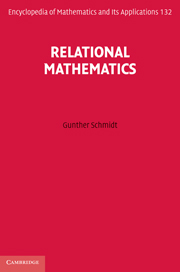Book contents
- Frontmatter
- Contents
- Notes on illustrations
- Preface
- 1 Introduction
- PART I REPRESENTATIONS OF RELATIONS
- PART II OPERATIONS AND CONSTRUCTIONS
- PART III ALGEBRA
- PART IV APPLICATIONS
- PART V ADVANCED TOPICS
- Appendix A Notation
- Appendix B Proofs postponed from Part II
- Appendix C Algebraic visualization
- Appendix D Historical annotations
- References
- Symbols
- Index
PART III - ALGEBRA
Published online by Cambridge University Press: 05 May 2013
- Frontmatter
- Contents
- Notes on illustrations
- Preface
- 1 Introduction
- PART I REPRESENTATIONS OF RELATIONS
- PART II OPERATIONS AND CONSTRUCTIONS
- PART III ALGEBRA
- PART IV APPLICATIONS
- PART V ADVANCED TOPICS
- Appendix A Notation
- Appendix B Proofs postponed from Part II
- Appendix C Algebraic visualization
- Appendix D Historical annotations
- References
- Symbols
- Index
Summary
In this part of the present text, we reach a third level of abstraction. Recall that in Part I relations were observed as they occur in real life situations. We then made a step forward using point-free algebraic formulation in Part II; however, we did not introduce the respective algebraic proofs immediately. Instead, we visualized the effects and tried to construct with relations. In a sense, this corresponds to what one always finds in a book treating eigenvectors and eigenvalues of real- or complexvalued matrices, or their invariant subspaces: usually this is heavily supported with visualizing matrix situations. We did this with full mathematical rigor but have not yet convinced the reader concerning this fact. Proofs, although rather trivial in that beginning phase, have been postponed so as to establish an easy line of understanding first.
As gradually more advanced topics are handled, we will now switch to a fully formal style with proofs immediately appended. However, the reader will be in a position to refer to the first two parts and to see there the effects.
Formulating only in algebraic terms – or what comes close to that, formulating in the relational language TituRel – means that we are far more restricted in expressivity. On the other hand this will improve the precision considerably. Restricting ourselves to the relational language will later allow computer-aided transformations and proofs.
- Type
- Chapter
- Information
- Relational Mathematics , pp. 155 - 156Publisher: Cambridge University PressPrint publication year: 2010

